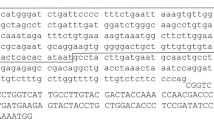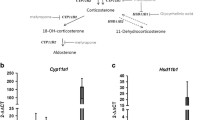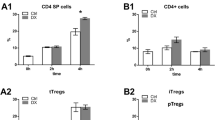Abstract
Cytotoxic T lymphocytes (CTL) induce a cytolytic process in target cells which, like the glucocorticoid-mediated cytolysis of immature thymocytes, effects a rapid and characteristic degradation of chromosomal DNA. I have explored the possibility that these two lethal processes share a common pathway by studying the suscepti-bility of glucocorticoid-resistant mutants to CTL-mediated killing. Here, I report that an unusual thymoma mutant, which has normal hormone receptor activity, is resistant to both glucocorticoids and CTL. The failure to be killed by CTL is not due to an inability of this 'deathless' mutant to be recognized. Further, a single-step reversion can restore sensitivity to both glucocorticoids and CTL. The genetic locus thus identified may reveal one element of an endogenous suicide pathway that can be triggered by different effectors. Unlike complement-mediated lysis, the processes of glucocorticoid- and CTL-mediated cytolysis seem to require that target cells be active in their own death.
Similar content being viewed by others
References
1. Podack, E. R. & Tschopp, J. /. biol. Chem. 257, 15204–15212 (1982). 2. Tschopp, J., Miiller–Eberhard, H. J. & Podack, E. R. Nature 298, 534–538 (1982). 3. Dourmashkin, R. R., Deteix, P., Simone, C. B. & Henkart, P. Clin. exp. Immun. 42, 554–560 (1980). 4. Dennert, G. & Podack, E. R. / exp. Med. 157, 1483–1495 (1983). 5. Henney, C. S. /. Immun. 110, 73–84 (1973). 6. Martz, E., Burakoff, S. J. & Benacerraf, B. Proc. natn. Acad. Sci. U.S.A. 71, 177–181 (1974). 7. Henkart, M. P. & Henkart, P. A. Adv. exp. Med. Biol. 146, 227–242 (1982). 8. Podack, E. R. & Dennert, G. Nature 302, 442–445 (1983). 9. Henkart, P. A., Millard, P. J., Reynolds, C. W. & Henkart, M. P. /. exp. Med. 160, 75–93 (1984). 10. Podack, E. R. & Konigsberg, P. J. /. exp. Med. 160, 695–710 (1984). 11. Masson, D. & Tschopp, J. J. biol. Chem. 260, 9096–9072 (1985). 12. Young, J. D.–E., Hengartner, H., Podack, E. R. & Conn, Z. A. Cell 44, 849–859 (1986). 13. Young, J. D.–E., Nathan, C. F., Podack, E. R., Palladino, M. A. & Cohn, Z. A. Proc. natn. Acad. Sci. U.S.A. 83, 150–154 (1986). 14. Russell, J. H., Masakowski, V. R. & Dobos, C. B. / Immun. 124, 1100–1105 (1980). 15. Russell, J. H. & Dobos, C. B. J. Immun. 125, 1256–1261 (1980). 16. Russell, J. H., Masakowski, V., Rucinsky, T. & Phillips, G. /. Immun. 128,2087–2094 (1982). 17. Duke, R. C., Chervenak, R. & Cohen, J. J. Proc. natn. Acad. Sci. U.S.A. 80,6361–6365 (1983). 18. Nicholson, M. L. & Young, D. A. Cancer Res. 38, 3673–3680 (1978). 19. Wyllie, A. H. Nature 284, 555–556 (1980). 20. Cohen, J. J. & Duke, R. C. /. Immun. 132, 38–42 (1984). 21. Vedeckis, W. V. & Bradshaw, H. D. Jr Molec. Cell. Endocr. 30, 215–227 (1983). 22. Sibley, C. H. & Tomkins, G. M. Cell 2, 221–227 (1974). 23. Yamamoto, K. R., Gehring, U., Stampfer, M. R. & Sibley, C. H. Recent Progr. Horm. Res. 32, 3–32 (1976). 24. Podak, E. R. Immun. Today 6, 21–27 (1985). 25. Russell, J. H. Immun. Rev. 72, 97–118 (1983). 26. Rabindran, S. K., Danielsen, M., Firestone, G. L. & Stallcup, M. R. Somat. Cell molec. Genet., 13, 131–143 (1987). 27. Ozato, K., Mayer, N. M. & Sachs, D. H. Transplantation 34, 113–120 (1982).
Author information
Authors and Affiliations
Rights and permissions
About this article
Cite this article
Ucker, D. Cytotoxic T lymphocytes and glucocorticoids activate an endogenous suicide process in target cells. Nature 327, 62–64 (1987). https://doi.org/10.1038/327062a0
Received:
Accepted:
Issue Date:
DOI: https://doi.org/10.1038/327062a0
- Springer Nature Limited
This article is cited by
-
Hinesol, a compound isolated from the essential oils of Atractylodes lancea rhizome, inhibits cell growth and induces apoptosis in human leukemia HL-60 cells
Journal of Natural Medicines (2015)
-
A review on biomolecular basis of the role of psychological stress in the development and progression of cancer
memo - Magazine of European Medical Oncology (2010)
-
β-Hydroxyisovalerylshikonin induces apoptosis in human leukemia cells by inhibiting the activity of a polo-like kinase 1 (PLK1)
Oncogene (2003)
-
Role of Ca2+ in the Intracellular Signaling Pathway of Anti-IgM—Induced Apoptosis in the Human B-Cell Line, MBC-1, Established from Burkitt Lymphoma
International Journal of Hematology (2002)
-
The timing of Drosophila salivary gland apoptosis displays an l(2)gl-dose response
Cell Death & Differentiation (2000)





